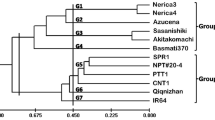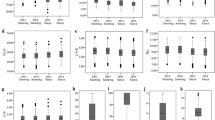Abstract
This study was undertaken to determine the relationship between genetic distance of the parents based on molecular markers and F1 performance in a set of diallel crosses involving eight commonly used parental lines in hybrid rice production. The F1s and their parents were measured for five traits including heading date, plant height, straw weight, grain yield and biomass. The parental lines were assayed for DNA polymorphisms using two classes of markers: 140 probes for restriction fragment length polymorphisms (RFLPs) and 12 simple sequence repeats (SSRs), resulting in a total of 105 polymorphic markers well spaced along the 12 rice chromosomes. SSRs detected more polymorphism than RFLPs among the eight lines. A cluster analysis based on marker genotypes separated these eight lines into three groups which agree essentially with the available pedigree information. Correlations were mostly low between general heterozygosity based on all the markers and F1 performance and heterosis. In contrast, very high correlations were detected between midparent heterosis and specific heterozygosity based on the markers that detected significant effects for all the five traits; these correlations may have practical utility in predicting heterosis. The analyses also suggest the existence of two likely heterotic groups in the rice germplasm represented by these eight lines.
Similar content being viewed by others
References
Bernardo R: Relationship between single-cross performance and molecular marker heterozygosity. Theor Appl Genet 83: 628–634 (1992).
Boppenmaier J, Melchinger AE, Seitz G, Geiger HH, Herrmann RG: Genetic diversity for RFLPs in European maize inbreds. III. Performance of crosses within versus between heterotic groups for grain traits. Plant Breed 111: 217–226 (1993).
Charcosset A, Lefort-Buson M, Gallais A: Relationship between heterosis and heterozygosity at marker loci: a theoretical computation. Theor Appl Genet 81: 571–575 (1991).
Dudley JW, Saghai Maroof MA, Rufener GK: Molecular markers and grouping of parents in maize breeding programs. Crop Sci 31: 718–723 (1991).
Godshalk EB, Lee M, Lamkey KR: Relationship of restriction fragment length polymorphisms to single-cross hybrid performance of maize. Theor Appl Genet 80: 273–280 (1990).
Hallauer AR, Miranda JB: Quantitative Genetics in Maize Breeding. Iowa State University Press, Ames (1988).
Lee M, Godshalk EB, Lamkey KR, Woodman WW: Association of restriction fragment length polymorphisms among maize inbreds with agronomic performance of their crosses. Crop Sci 29: 1067–1071 (1989).
Lin S, Ming S: Rice Varieties and Their Genealogy in China. (In Chinese.) Shanghai Science and Technology Press, Shanghai (1991).
Melchinger AE, Lee M, Lamkey KR, Woodman WL: Genetic diversity for restriction fragment length polymorphisms: relation to estimated genetic effects in maize inbreds. Crop Sci 30: 1033–1040 (1990).
Messmer MM, Melchinger AE, Herrmann RG, Boppenmaier J: Relationships among early European maize inbreds. II. Comparison of pedigree and RFLP data. Crop Sci 33: 944–950 (1993).
Moll RH, Lonnquist JH, Vélez Fortuno J, Johnson EC: The relationship of heterosis and genetic divergence in maize. Genetics 52: 139–144 (1965).
O'Brien SJ: Genetic Maps, Book 6, Plants. Cold Spring Harbor Laboratory Press, Cold Spring Harbor, NY (1992).
Peng JY, Glaszmann JC, Virmani SS: Heterosis and isozyme divergence in indica rice. Crop Sci 28: 561–563 (1988).
Rice Research Group of Mian Yang Agricultural Institute of Sichuan Province: an analysis on heterosis of F1 hybrids in rice. Acta Sin Genet 5: 158–164 (1978).
Saghai Maroof MA, Soliman KM, Jorgensen RA, Allard RW: Ribosomal DNA spacer-length polymorphisms in barley: Mendelian inheritance, chromosomallocation, and population dynamics. Proc Natl Acad Sci USA 81: 8014–8018 (1984).
Saghai Maroof MA, Zhang Q, Biyashev RM: Molecular marker analyses of powdery mildew resistance in barley. Theor Appl Genet 88: 733–740 (1994).
Smith OS, Smith JSC, Bowen SL, Tenborg RA, Wall SJ: Similarities among a group of elite maize inbreds as measured by pedigree, F1 grain yield, grain yield heterosis and RFLPs. Theor Appl Genet 80: 833–840 (1990).
Sokal R, Sneath PHA: Principles of Numerical Taxonomy. Freeman, San Francisco/London (1963).
Steel RGD, Torrie JH: Principles and Procedures of Statistics. McGraw-Hill, New York (1980).
Stuber CW: Molecular markers in the manipulation of quantitative characters. In: Brown AHD, Clegg MT, Kahler AL, Weir BS (eds) Plant Population Genetics, Breeding, and Genetic Resources, pp. 334–350. Sinauer Associates, Sunderland, MA (1989).
Tanksley S, Causse M, Fulton T, Ahn N, Wang Z, Wu K, Xiao J, Yu Z, Second G, McCouch S: A high density molecular map of the rice genome. Rice Genet Newsl 9: 111–115 (1992).
Virmani SS, Aquino RC, Khush GS: Heterosis breeding in rice. Theor Appl Genet 63: 373–380 (1982).
Ward JH: Hierarchical grouping to optimize an objective function. J Am Stat Ass 58: 236–244 (1963).
Wu KS, Tanksley SD: Abundance, polymorphism and genetic mapping of microsatellites in rice. Mol Gen Genet 241: 225–235 (1993).
Yang GP, Saghai Maroof MA, Xu CG, Zhang Q, Biyashev RM: Comparative analysis of microsatellite DNA polymorphism in landraces and cultivars of rice. Mol Gen Genet, in press (1995).
Young JB, Virmani SS: Heterosis in rice over environments. Euphytica 51: 87–93 (1990).
Yuan LP: Development and prospects of hybrid rice breeding. In: You C, Chen ZL (eds) Agricultural Biotechnology. Proceedings Asia-Pacific Conference on Agricultural Biotechnology, Beijing, August 20–24, 1992, pp. 97–105 (1992).
Zhang Q, Saghai Maroof MA, Lu TY, Shen BZ: Genetic diversity and differentiation ofindica andjaponica rice detected by RFLP analysis. Theor Appl Genet 83: 495–499 (1992).
Zhang Q, Gao YJ, Yang SH, Ragab R, Saghai Maroof MA, Li ZB: A diallel analysis of heterosis in elite hybrid rice based on RFLPs and microsatellites. Theor Appl Genet, in press (1995).
Author information
Authors and Affiliations
Rights and permissions
About this article
Cite this article
Zhang, Q., Gao, Y.J., Maroof, M.A.S. et al. Molecular divergence and hybrid performance in rice. Mol Breeding 1, 133–142 (1995). https://doi.org/10.1007/BF01249698
Received:
Accepted:
Issue Date:
DOI: https://doi.org/10.1007/BF01249698




